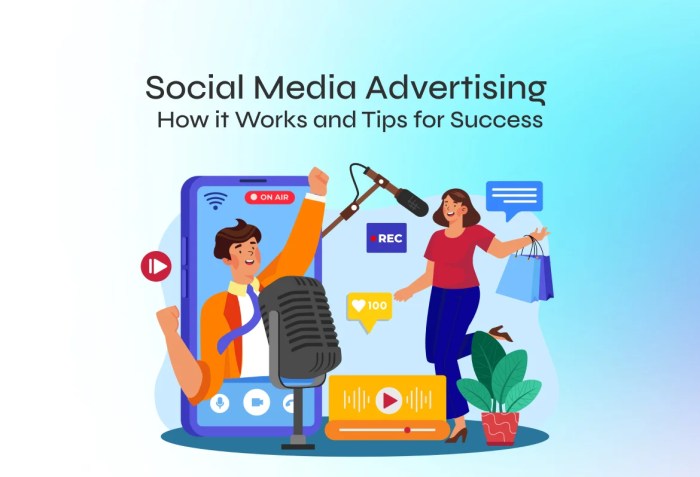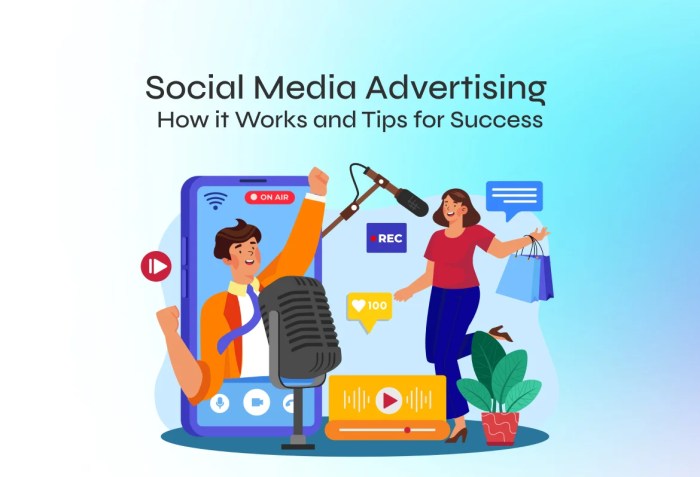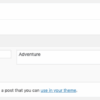Social media ads 101 is your essential guide to navigating the world of online advertising. From understanding the basics of different platforms to crafting compelling visuals and copy, we’ll cover everything you need to launch successful campaigns. We’ll explore the key differences between social media ads and traditional methods, plus how to target the right audience for maximum impact.
This comprehensive guide will equip you with the knowledge and strategies to create effective ad campaigns across various platforms like Facebook, Instagram, TikTok, and Twitter. We’ll delve into account setup, audience targeting, ad format selection, budgeting, and performance tracking. Learn how to avoid common pitfalls and optimize your ads for maximum results.
Introduction to Social Media Ads
Social media advertising has become an indispensable part of modern marketing strategies. It leverages the vast user bases and intricate targeting capabilities of platforms like Facebook, Instagram, and TikTok to connect businesses with potential customers in a highly personalized way. This approach allows for precise targeting, measurable results, and a dynamic interaction between brands and consumers, leading to a significant return on investment for many companies.Social media advertising differs from traditional methods in several key aspects.
Traditional advertising often relies on broadcasted messages, reaching a large, yet often less engaged audience. Social media ads, in contrast, allow for a more tailored approach, focusing on specific demographics, interests, and behaviors. This targeted approach improves the effectiveness of the campaign by reducing wasted ad spend and enhancing engagement. The ability to track metrics and adjust campaigns in real-time further distinguishes social media advertising from its predecessors.
Social Media Platforms for Advertising
Various social media platforms offer advertising opportunities. Facebook and Instagram, with their massive user bases, remain popular choices for reaching a wide audience. These platforms excel at detailed targeting options, allowing businesses to segment their audience based on age, location, interests, and behaviors. TikTok, with its short-form video format, provides a unique avenue for engaging younger audiences and showcasing products or services in a creative way.
Twitter, known for its real-time updates and trending topics, allows for engaging with conversations and reaching audiences interested in specific news or discussions. The choice of platform depends largely on the target audience and marketing objectives.
Evolution of Social Media Advertising, Social media ads 101
Social media advertising has undergone a significant transformation since its inception. Early forms of advertising on platforms like Facebook focused primarily on basic demographic targeting. The introduction of sophisticated algorithms and machine learning has allowed for a more refined understanding of user behavior and preferences, resulting in increasingly personalized ad experiences. The emergence of video and interactive ad formats has also greatly enhanced user engagement and conversion rates.
Real-time bidding and programmatic advertising have further streamlined the process, making advertising more efficient and cost-effective.
Comparison of Social Media Platforms
| Platform | Ad Formats | Targeting Options |
|---|---|---|
| Image ads, video ads, carousel ads, lead generation ads, collection ads, and more | Detailed targeting based on demographics, interests, behaviors, and custom audiences. | |
| Image ads, video ads, carousel ads, stories ads, and shopping ads. | Targeting similar to Facebook, with emphasis on visual targeting and engagement with influencer marketing. | |
| TikTok | Video ads (short-form and in-feed), brand challenges, and branded effects. | Targeting based on interests, demographics, and in-app behaviors. Trending challenges and hashtags play a key role. |
| Image ads, video ads, promoted tweets, and promoted trends. | Targeting based on s, interests, and demographics. Engagement with real-time conversations is crucial. |
The table above provides a brief overview of different platforms’ advertising capabilities. Each platform offers a unique set of features, allowing businesses to tailor their campaigns to specific audiences and objectives. Understanding these nuances is crucial for maximizing the return on investment from social media advertising.
Social media ads 101 is all about crafting compelling campaigns, but sometimes you need a little extra boost. Understanding strategies like parasite SEO, which involves using a website’s existing authority to improve another site’s ranking, parasite seo what is it , can help your social media ad reach a wider audience. Ultimately, mastering these techniques can significantly enhance your social media ad performance.
Setting Up Your Social Media Ad Account
Creating a social media ad account is the first crucial step in launching a successful ad campaign. A well-structured account, meticulously filled with the correct information, is the foundation for effective targeting, measurement, and ultimately, reaching your desired audience. This process, while seemingly straightforward, requires attention to detail and a thorough understanding of the specific requirements of each platform.
Ignoring these details can lead to account rejection, hampered campaign performance, or even wasted ad spend.Setting up your social media ad account is not just a technical exercise; it’s a strategic move. Accurate information ensures that your ads reach the right people, optimizing your campaign’s return on investment. By meticulously following the steps and providing accurate information, you’ll be well-positioned to maximize the impact of your ad campaigns.
Account Creation Steps and Requirements
Creating a social media ad account is a multi-step process. Each platform has its own set of guidelines and prerequisites, requiring specific information for verification and account approval. Understanding these requirements is paramount to avoid delays or rejection.
Necessary Information for Each Platform
Different platforms have varying information requirements for ad account creation. Careful attention to detail is critical, as inconsistencies can lead to delays or rejection. Here’s a table outlining the necessary information for common platforms:
| Platform | Required Information |
|---|---|
| Facebook Ads | Business profile details, payment information, website URL, contact information, and potentially specific campaign objectives. |
| Instagram Ads | Linked Facebook Business profile, payment information, business details, and target audience information. |
| Twitter Ads | Business profile details, payment information, and target audience insights. |
| LinkedIn Ads | Company profile details, business objectives, target audience information, and payment information. |
| TikTok Ads | Business profile details, payment information, and target audience preferences, along with specific campaign goals. |
Best Practices for Account Optimization
Beyond the basic requirements, optimizing your account for maximum effectiveness is crucial. This involves ensuring accuracy, completeness, and strategic alignment with your campaign goals.
- Accuracy and Completeness: Providing accurate and comprehensive information is paramount. Inaccurate details can lead to difficulties with ad approvals or, worse, ad rejection. Ensure your profile accurately reflects your brand and campaign objectives.
- Target Audience Alignment: Precisely define your target audience within the ad platform. Detailed targeting options, while available, will only be effective when properly utilized with a clear understanding of your desired customer demographic.
- Clear Business Objectives: Establish clear campaign goals and objectives. This should guide the entire setup and creation process, from initial account creation to ad copy and targeting.
- Verification and Approval: Actively monitor the account setup process, paying close attention to verification requests and approval steps. Addressing any requests promptly is vital for avoiding delays.
Defining Your Target Audience

Knowing your target audience is crucial for crafting effective social media ad campaigns. Understanding who you’re trying to reach allows you to tailor your messaging, visuals, and ad placement to resonate with them, maximizing your return on investment. Without a clear understanding of your ideal customer, your ads are likely to fall flat, wasting your budget and potentially missing out on valuable conversions.Effective campaigns zero in on specific needs and desires within a particular group, optimizing the ad’s impact.
This precision targeting increases the chances of attracting the right customers and driving the desired outcomes.
Importance of Identifying Your Target Audience
A well-defined target audience is paramount to a successful social media ad campaign. It ensures your message is relevant and engaging, maximizing your ad’s impact. This targeted approach leads to higher conversion rates and a more efficient use of your advertising budget. Precisely targeting your audience with relevant ads increases engagement and reduces wasted ad spend.
Strategies for Identifying Your Target Audience
Identifying your target audience involves a multi-faceted approach, examining demographics, interests, and behaviors. Start by gathering information about your existing customers. Analyze their purchase history, demographics, and engagement patterns. This will provide valuable insights into who is currently interacting with your brand. A comprehensive understanding of your target audience enables you to create marketing campaigns that effectively resonate with their needs.
Demographic Segmentation
Understanding demographic factors such as age, gender, location, income, and education level allows you to tailor your messaging and visuals to specific groups. For example, an ad for a luxury skincare product might target women aged 35-55 with high disposable income in urban areas.
Interest-Based Segmentation
Understanding your target audience’s interests is vital for crafting relevant content. Identify the hobbies, passions, and online activities that your ideal customer engages in. Consider using social media analytics tools to identify common interests among your followers or customers.
So, you’re diving into social media ads 101? Understanding how to craft effective campaigns is key, but knowing what a successful sales funnel looks like is equally important. A profitable social media sales funnel, for example, needs a clear path from initial awareness to final conversion, and what does a profitable social media sales funnel look like will help you design one.
Ultimately, mastering social media ads 101 hinges on understanding this crucial funnel structure.
Behavioral Segmentation
Analyzing customer behavior, such as purchase history, website interactions, and app usage, allows you to tailor your messaging to their specific needs and preferences. This detailed approach enables you to create personalized experiences that encourage engagement and conversions. Understanding past purchasing behaviors is a valuable insight for creating more effective campaigns.
Using Audience Insights Tools and Data Analysis
Leveraging audience insights tools and data analysis allows you to refine your target audience further. These tools provide valuable demographic information, interests, and behaviors, enabling you to create more effective and targeted ad campaigns. This analysis allows you to understand your target audience’s preferences and adjust your campaigns accordingly.
Segmenting Your Target Audience for Customized Campaigns
Once you’ve identified your target audience, segment them into smaller groups based on shared characteristics. This segmentation allows for customized ad campaigns that resonate with each specific group’s unique needs and preferences. Tailored campaigns based on segment-specific interests improve ad effectiveness and ROI.
Questions to Ask Yourself When Defining Your Target Audience
Defining your target audience requires careful consideration of several key factors. Consider these questions:
- Who are my ideal customers? What are their demographics, interests, and behaviors?
- Where do they spend their time online? What social media platforms do they frequent?
- What are their needs and pain points? How can my product or service address these?
- What are their motivations for making a purchase?
- What are their values and beliefs?
- What are their current challenges and aspirations?
- What are their preferred communication styles?
Crafting Compelling Ad Copy and Visuals
Crafting compelling ad copy and visuals is crucial for achieving success in social media advertising. Effective ads capture attention, communicate your message clearly, and motivate desired actions. This involves understanding your target audience, selecting the right platforms, and creating visually appealing content. The key is to combine engaging copy with compelling visuals that resonate with your audience, driving them to take action.Effective ad copy and visuals work in tandem to create a powerful message that resonates with the audience.
The copy should be concise, clear, and persuasive, while the visuals should be visually appealing and complement the message. This combination creates a memorable experience for the user, increasing the likelihood of conversion.
Compelling Ad Copy Examples
Ad copy varies significantly across social media platforms. Consider the platform’s unique characteristics when crafting your message. For instance, concise copy works well on Twitter, while longer-form copy might be suitable for Facebook. Short, punchy headlines are ideal for grabbing attention quickly.
- Facebook: “Upgrade your wardrobe with our 20% off sale! Shop now and enjoy the best deals on new arrivals. Limited time offer!” This copy uses a clear call to action and highlights a benefit (discount).
- Instagram: “Effortless style starts with the right accessories. ✨ Check out our latest collection of statement jewelry. Link in bio.” This copy is visually engaging with emojis and uses a call to action to drive traffic to a website.
- Twitter: “New product launch! 🚀 Our innovative [product name] is now available. Learn more and order now: [link]. #newproduct #innovation.” The use of relevant hashtags and a concise message are key elements.
- TikTok: “Quick and easy recipe for [dish]. Watch our video for the step-by-step instructions. #easyrecipe #foodie #cooking.” This copy focuses on creating intrigue and encourages engagement.
Elements of Effective Ad Copy
Effective ad copy comprises several crucial elements. Headlines grab attention, body text provides details, and calls to action motivate the desired response.
- Headlines: Headlines should be concise, compelling, and relevant to the ad’s visual. They should quickly communicate the ad’s value proposition.
- Body Text: The body text should expand on the headline, providing further details about the product or service and its benefits. It should be persuasive and address the needs of the target audience.
- Calls to Action (CTAs): CTAs should be clear, concise, and motivate users to take action, such as “Shop Now,” “Learn More,” or “Sign Up.”
Visual Appeal in Social Media Ads
Visual appeal is critical for social media ads. Eye-catching visuals can capture attention, convey information effectively, and create a lasting impression. High-quality images and videos are essential for creating a strong visual presence.
- High-Quality Images/Videos: Ensure your visuals are sharp, clear, and well-lit. Avoid blurry or pixelated images, as they can detract from the overall message.
- Brand Consistency: Maintain consistency in your brand’s visual identity across all your ads. This includes using your brand colors, fonts, and logos.
- Target Audience Relevance: Ensure that your visuals resonate with your target audience. Consider their interests, preferences, and needs when selecting images and videos.
Tips for Creating Eye-Catching Visuals
Visuals are critical for grabbing attention and conveying your message effectively. High-quality images and videos, consistent branding, and audience relevance are key factors.
- High-Quality Images/Videos: Ensure your visuals are sharp, clear, and well-lit. Professional-quality visuals create a more credible impression.
- Use of Color and Composition: Strategic use of color and composition can draw attention and create a visually appealing ad. Experiment with different layouts and color palettes to find what works best for your target audience.
- Storytelling Through Visuals: Use visuals to tell a story that resonates with your target audience. Consider incorporating movement and animation to make your ads more engaging.
Ad Copy Styles and Visuals
The following table illustrates different ad copy styles and corresponding visuals to enhance engagement.
| Ad Copy Style | Visual Description |
|---|---|
| Promotional Sale | High-quality images of products on sale, with prominent price tags. Use vibrant colors and clear typography. |
| Informative Product Demo | A short video showcasing the product’s features and benefits, with clear captions and text overlays. |
| Lifestyle-Oriented | Images of people enjoying the product in everyday situations. Use natural lighting and a relatable aesthetic. |
| Problem/Solution | Images illustrating a problem and how the product solves it. Use clear before-and-after visuals or comparisons. |
Choosing the Right Ad Formats
Social media ads offer a plethora of formats, each designed to engage users in a unique way. Understanding these formats and their strengths and weaknesses is crucial for crafting effective campaigns. Knowing which format best suits your marketing objectives will significantly impact your ad’s performance and ROI.Different platforms have different ad formats, each tailored to the platform’s unique user experience.
Optimizing your ad format to align with the specific social media platform ensures that your message resonates effectively with the target audience.
So, you’re diving into social media ads 101? Knowing how to craft compelling ad copy is key, but don’t forget about protecting your intellectual property. It’s crucial to understand how to safeguard your writing online, especially when using it for advertising campaigns. Learning about protecting your writing online can help you avoid copyright issues and plagiarism concerns, ensuring your ads stand out and don’t get flagged.
Ultimately, this knowledge is essential for success in the world of social media ads.
Available Ad Formats on Social Media
Various ad formats are available across different social media platforms, offering diverse ways to present your message. The choice of format hinges on your specific goals and the platform’s characteristics.
- Image Ads: These are simple, visually-driven ads that use compelling images to capture attention. They’re effective for showcasing products or services and are particularly useful for brand awareness campaigns. Visual appeal is key, and high-quality images are essential for maximizing impact. Examples include product shots, lifestyle imagery, or infographics.
- Video Ads: Video ads can be more engaging than static images, effectively communicating messages with motion and sound. They can effectively convey complex information or highlight product features, especially beneficial for showcasing product demonstrations or explaining services. Short-form videos are highly engaging on platforms like TikTok and Instagram, while longer videos are often used on Facebook and YouTube for more detailed information.
- Carousel Ads: Carousel ads allow for multiple images or videos in a single ad, providing a more in-depth look at your products or services. These are great for showcasing multiple products, highlighting different features, or providing a step-by-step guide. Carousel ads are often seen on Instagram, Facebook, and Pinterest.
- Collection Ads: Collection ads are a specific format designed to showcase a variety of products or services within a single ad. They often include a prominent image or video and offer a seamless transition to a product page. They are particularly useful for e-commerce businesses, enabling customers to browse and purchase multiple items directly from the ad.
- Story Ads: These ads appear directly within a platform’s story feature, blending seamlessly with the user experience. Their ephemeral nature requires a concise and attention-grabbing message, often using short-form videos or engaging graphics to convey information quickly. They are popular for promotions and driving immediate engagement.
- Interactive Ads: These ads allow users to interact with the ad directly, enhancing engagement and collecting valuable data. Quizzes, polls, and surveys are examples of interactive ad formats, encouraging users to actively participate and provide feedback.
Strengths and Weaknesses of Different Ad Formats
Understanding the strengths and weaknesses of each format is crucial for strategic selection.
| Ad Format | Strengths | Weaknesses |
|---|---|---|
| Image Ads | Simple, cost-effective, suitable for showcasing products | Can be less engaging than video or carousel ads, may lack detail |
| Video Ads | Highly engaging, effectively communicate complex information | Can be more expensive to produce, require more time to create |
| Carousel Ads | Showcase multiple products, offer detailed information | Can be complex to design and manage, may not be suitable for all products |
| Collection Ads | Easy to shop directly from the ad | Limited in scope, primarily for e-commerce products |
| Story Ads | Blend seamlessly with the platform’s user experience, high visibility | Ephemeral nature requires concise messaging, less space for details |
| Interactive Ads | High user engagement, collect valuable data | Requires careful design to maintain user interest, potentially complex to implement |
Selecting the Optimal Ad Format
Several factors influence the optimal ad format selection. Your campaign objectives, target audience, and budget all play significant roles in making the right decision. Analyzing these elements ensures your chosen format effectively drives your desired outcome.
- Brand Awareness: Image ads, video ads, and carousel ads can be effective for building brand awareness, particularly when combined with strong visuals and engaging copy. Their ability to quickly capture attention makes them well-suited for increasing brand recognition.
- Lead Generation: Interactive ads, such as quizzes or polls, can be excellent for collecting leads and gathering user data. These formats encourage user interaction and provide valuable insights about your target audience.
- Sales: Collection ads, showcasing multiple products, are highly effective for driving sales. Their ease of navigation and direct shopping experience make them well-suited for driving conversions.
Setting a Budget and Tracking Results

Knowing how to allocate your budget effectively and track your results is crucial for successful social media advertising. Without a clear strategy and consistent monitoring, your campaigns can quickly become costly and ineffective. This section delves into the importance of budgeting, different strategies, and the key metrics for evaluating your ad performance.A well-defined budget is not just about saving money; it’s about ensuring you’re maximizing your return on investment (ROI).
A carefully considered budget will allow you to allocate resources where they will yield the best results, ensuring that your advertising efforts align with your overall business goals.
Importance of a Realistic Budget
A realistic budget is vital for social media advertising. It prevents overspending and allows for adjustments based on campaign performance. Setting a budget that is too low may limit your reach and impact, while a budget that is too high can be wasteful if not managed effectively. A realistic budget ensures you can adapt to the evolving needs of your campaigns and optimize your spending for the best possible outcomes.
Budgeting Strategies and Models
Different budgeting models can be used for social media ads, each with its own advantages and disadvantages. Some common models include:
- Fixed Budget: A fixed amount is allocated for the entire campaign duration. This approach is straightforward, but it may not be optimal for campaigns with varying performance needs. It is best used for campaigns with predictable outcomes.
- Performance-Based Budget: This model allocates funds based on the campaign’s performance. As impressions, clicks, or conversions increase, more budget is allocated. Conversely, if performance is low, budget is adjusted to avoid further losses.
- Trial and Error Budget: Start with a small budget and track results closely. Based on initial performance, adjust your budget for future campaigns. This allows for continuous learning and refinement of your strategy.
Allocating Budget Across Campaigns
Allocating your budget across different ad campaigns depends on various factors, including your target audience, campaign goals, and the platform. Consider the following factors:
- Platform Performance: Some platforms may perform better than others for your target audience. Allocate a larger portion of your budget to platforms where you see a higher return on investment.
- Campaign Goals: If one campaign focuses on brand awareness, you might allocate a larger budget for broader reach, while a campaign focused on conversions might need a higher budget for targeted ads.
- Target Audience Segmentation: If you are targeting multiple audience segments, allocate budget proportionally based on the size and potential of each segment.
Tracking and Measuring Ad Performance
Tracking social media ad performance is crucial for optimizing campaigns. Key metrics allow you to understand what’s working and what needs improvement.
- Metrics to Analyze Campaign Performance: Important metrics for analyzing your social media ad campaigns include impressions, clicks, conversion rates, and cost-per-click (CPC).
- Impressions: The number of times your ad was displayed. A high number of impressions indicates broader reach, but it doesn’t necessarily translate into engagement or conversions.
- Clicks: The number of times users clicked on your ad. This is a critical metric, as it indicates user interest and engagement with your ad.
- Conversion Rate: The percentage of users who completed a desired action (e.g., making a purchase, signing up for a newsletter) after clicking your ad. A high conversion rate signifies that your ad effectively drives desired outcomes.
- Cost-per-Click (CPC): The amount you pay each time a user clicks on your ad. A lower CPC is generally better, as it indicates efficiency in your ad spend.
Example of Budget Allocation
For a company selling clothing, a fixed budget of $500 could be allocated as follows:
| Campaign | Platform | Budget | Rationale |
|---|---|---|---|
| Brand Awareness | $200 | Targeting a broader audience to increase brand visibility. | |
| Conversion | $200 | Focusing on specific demographics to drive sales. | |
| Retargeting | Both | $100 | Reacting to users who previously interacted with the brand. |
Optimizing Your Social Media Ads: Social Media Ads 101
Social media advertising is a dynamic field. What works today might not tomorrow. Constantly optimizing your campaigns is crucial for maximizing your return on investment (ROI). This involves more than just setting up a campaign and leaving it to run. It requires a proactive approach to analyzing performance, identifying areas for improvement, and adapting your strategies accordingly.Continuous optimization ensures your ads remain relevant to your target audience, increasing engagement and conversions.
This is a critical aspect of achieving long-term success in the ever-evolving landscape of social media marketing.
Analyzing Campaign Data for Improvement
Understanding your campaign’s performance is the cornerstone of optimization. Thorough analysis of key metrics allows you to identify trends, pinpoint areas for improvement, and make data-driven decisions. Look at metrics like click-through rates (CTR), conversion rates, cost per click (CPC), and cost per acquisition (CPA). Analyzing this data helps to determine what’s working and what isn’t, providing actionable insights.
For instance, a low CTR might indicate that your ad copy or visuals aren’t engaging enough.
A/B Testing Ad Elements
A/B testing is a powerful technique to refine different aspects of your social media ads. By creating variations of your ad elements, you can determine which versions resonate best with your target audience. This method allows you to systematically test different ad copy, images, and targeting options. For example, you could test two different headlines, two different calls to action, or two different images to see which performs better.
Refining Ad Campaigns Based on Performance Data
Adapting your ad campaigns based on performance data is crucial for maximizing ROI. This involves making informed adjustments to your targeting, copy, and visuals based on the insights you gather from your analysis. If a particular ad copy isn’t performing well, you can modify it to be more compelling. Similarly, you can adjust your targeting to focus on segments of your audience that are more receptive to your message.
Adjusting Ad Targeting, Copy, and Visuals
Adjustments to ad targeting, copy, and visuals are crucial to improving results. If a particular demographic isn’t responding to your ads, consider refining your targeting to focus on a more receptive segment. For example, if your ad copy is too technical for your target audience, you might need to reword it to be more accessible and engaging. Similarly, if your visuals are not visually appealing or fail to convey your message effectively, a change in the image or video can greatly improve engagement.
Example of Ad Optimization
Imagine an e-commerce business running a Facebook ad campaign promoting a new line of athletic shoes. The initial campaign shows a low conversion rate. Analyzing the data reveals that the ad copy is too generic and the visuals lack a clear call to action. To optimize, they A/B test different ad copy options. One version focuses on the comfort and performance of the shoes, while another highlights the unique design features.
They also create visuals that emphasize the key benefits of the product, such as improved support or breathability. After analyzing the data, they choose the copy and visuals that perform best and modify their targeting to focus on athletic enthusiasts. The result is a significant increase in conversion rates.
Common Mistakes to Avoid
Social media advertising offers incredible potential, but it’s easy to stumble. Understanding common pitfalls is crucial for maximizing your campaign’s return on investment (ROI). This section highlights the most frequent errors and provides actionable strategies to steer clear of them. Avoiding these mistakes will help you achieve your goals and create a successful social media advertising campaign.
Ignoring Your Target Audience
Defining your ideal customer is fundamental to successful advertising. Failing to deeply understand your target audience’s needs, interests, and online behavior leads to irrelevant messaging and wasted ad spend. This often manifests as broad targeting, failing to consider specific demographics, psychographics, or online habits. Instead of casting a wide net, focus on a well-defined segment. For instance, a company selling hiking gear shouldn’t target everyone interested in outdoor activities; they should focus on avid hikers and campers.
This refined approach ensures your message resonates with the right people, leading to higher conversion rates.
Creating Unengaging Content
Creating content that grabs attention and encourages interaction is paramount. Many campaigns fall short by using generic images or copy that fails to connect with the audience. Visuals should be high-quality and evoke emotions, while copy should be concise, compelling, and relevant to the target audience. Instead of generic statements, try incorporating storytelling or humor. A brand selling clothing could use images showcasing customers enjoying their clothes in a captivating environment, along with copy that highlights the unique features and benefits.
This approach fosters stronger connections with your audience and generates more engagement.
Failing to Track and Analyze Results
Tracking your campaign’s performance is crucial for identifying areas for improvement. Ignoring analytics prevents you from understanding what’s working and what’s not. This can lead to wasted resources and missed opportunities to optimize your campaigns. Instead of simply running ads and hoping for the best, closely monitor key metrics like click-through rates (CTR), conversion rates, and cost per acquisition (CPA).
This data helps you fine-tune your strategies and optimize your campaigns in real-time.
Inadequate Budgeting and Scheduling
A poorly defined budget can lead to ineffective campaigns. Allocating insufficient funds for your campaign will limit the reach and impact of your ads. Also, an inconsistent or poorly planned schedule can result in missed opportunities and decreased visibility. Allocate a realistic budget based on your goals and target audience. For example, a new business might start with a smaller budget and scale it up as they gain more traction.
Establish a clear schedule that aligns with your target audience’s online activity.
Table: Common Mistakes and How to Avoid Them
| Mistake | Explanation | How to Avoid |
|---|---|---|
| Ignoring Target Audience | Broad targeting, failing to understand customer needs. | Deeply research your ideal customer, consider demographics, psychographics, and online behavior. |
| Unengaging Content | Generic images and copy, lacking emotional connection. | Use high-quality visuals, tell stories, incorporate humor, and write compelling copy. |
| Failing to Track Results | Ignoring analytics, missing opportunities for optimization. | Monitor key metrics (CTR, conversion rates, CPA). |
| Inadequate Budgeting/Scheduling | Insufficient funds, inconsistent schedule. | Allocate a realistic budget, align schedule with target audience activity. |
Final Thoughts
In conclusion, mastering social media advertising isn’t just about knowing the tools; it’s about understanding your audience, crafting engaging content, and meticulously tracking results. By following the strategies Artikeld in this guide, you can create successful ad campaigns that drive meaningful engagement and achieve your marketing goals. So, get ready to unlock the potential of social media advertising!






